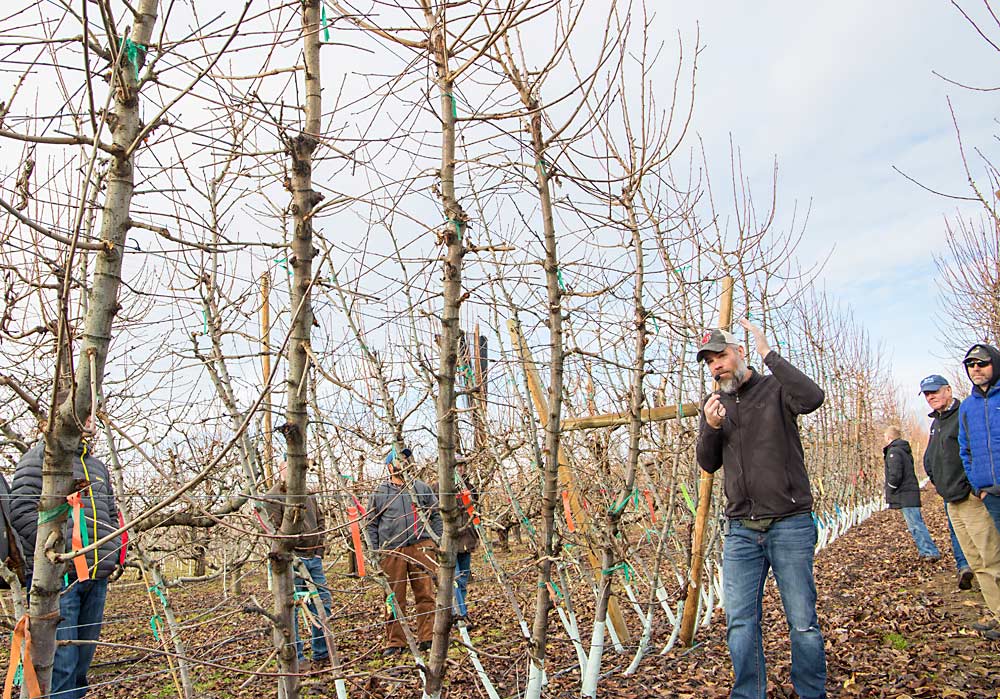
Cherry systems that capture light more uniformly and can be easily maintained to sustain productivity will be the future of orchard efficiency, according to Washington State University horticulturist Matt Whiting. Excessive vigor up high is an ongoing pruning problem in this system in a Washington Fruit and Produce Co. orchard near Mattawa, Washington, as seen during the annual pre-Cherry Institute tour in January. (Ross Courtney/Good Fruit Grower)
How will your cherry orchards look in 20 years?
From the diversity of systems favored by sweet cherry growers today, Washington State University horticulturist Matt Whiting predicts a return to simplicity, with two-dimensional systems that allow “almost assembly line-style” maintenance and take advantage of the tree’s inherent growth habit.
“We’re going back to the future,” he said, referencing the tradition of the espaliered trees that graced the walls of 17th century monasteries. “A compact wall of fruit, with predictable fruiting and vigor and high-input efficiency, allows precision orchard management.”
That’s the vision he shared with attendees at the Cherry Fruit School, organized by WSU and Oregon State University in March.
System decisions are guided by site, cultivar, rootstock, light and topography, to name a few, he said, but the important questions should include:
—How easy is it to maintain?
—How much does it cost to establish?
—How quickly does it get to production?
—How long is that productivity sustainable?
Growers can find answers to help them make decisions today in the Cherry Training Systems guide, published by OSU and WSU in 2015, but as Whiting quipped, apple training systems don’t need a book.
Fruiting wall systems would let cherry growers take advantage of platforms for limb tying, thinning, pruning and harvest, he said, improving efficiency.
“Maybe this is a new way to think about a pedestrian orchard,” Whiting said, since platforms reduce ladder-related accidents as well. “How many accidents are you having based on the tools and techniques people need to use to maintain the systems?”
He cited two fruiting wall systems as examples: the UFO (Upright Fruiting Offshoots) style and the Tatura style. Both provide simplified fruiting units for simple maintenance pruning and good light interception. But while the UFO system employs permanent horizontal wood and renewal of vertical fruiting wood, the Tatura system flips that sideways.
These planar canopies capitalize on growth habits cherry trees evolved for capturing light as efficiently as possible, said Michigan State University physiologist Greg Lang, in a presentation on how cherry physiology should inform system design.
“We get a lot of efficiencies if we break the tree down to how it fundamentally likes to grow,” Lang said.
Physiological foundation
At this point, growers are used to hearing the recommendation to consider how their trees intercept light, but Lang said, it’s equally important to think about managing shade. That’s because it’s the balance of sun interception, the uniformity across the tree, that matters for fruit quality.
“The higher the proportion of the fruit that is exposed to adequate sunlight, the more uniform will be fruit ripening, quality and postharvest performance,” Lang said. “Sun-exposed fruit lose more water than shaded fruit, but this also drives the import of more sugar and more nutrients and promotes greater fruit growth overnight.”
As shoots grow, each new leaf develops at an angle that is 137.5 degrees from the previous leaf, Lang said, moving into the best position to create minimal shading of the previous leaf. Then, new shoots develop from those same growing points, maintaining this high-efficiency pattern.
“But by year two or three, shade starts increasing and we start losing carbon on the inside of the canopy,” he said. “That’s where we come in to start pruning and training to bring the tree back to optimize its light interception.”
Lang shared insights from his research trials over the years showing exactly how much leaf area trees need to support the optimum development of fruit and the importance of balanced crop load from a photosynthesis perspective.
Fruit size and sugars reach their maximum around 210 to 250 square centimeters of leaf area, surprisingly consistent findings in separate trials in Bing and Skeena, Lang said. That’s two to three shoot leaves or four to eight smaller spur leaves per fruit.
“So now we have some targets on the leaf area we want to manage, and it’s all about arranging that leaf area on the tree,” he said. And leaves are not all created equally when it comes to their contribution of carbon to the fruit, he explained, citing a trial using carbon dioxide with a tracer that allowed the researchers to follow the carbon absorbed by fruiting spur leaves, nonfruiting spur leaves, and shoot leaves as it was distributed throughout the tree.
They found that fruiting spur leaves provide the most carbon to the fruit, followed by the nonfruiting spur leaves, with the new shoot leaves mostly contributing to shoot growth, except during the period of peak fruit growth. Managing those three “populations of leaves” through orchard systems can help keep the tree balanced in terms of crop load to leaf area, Lang said.
As the crop load gets too high, relative to leaf area, the carbon tracing system shows just how this balance gets out of whack, with more carbon going to the fruit on the upper spur that gets first dibs on the resources flowing from the nonfruiting spur leaves. There’s not enough left to support the fruit farther away.
“We’re seeing nonuniformity in the carbon being delivered to the fruit,” Lang said. “That directly affects your ability to grow a very high-quality piece of fruit with good sugar and good firmness harvested throughout the tree.” •
—by Kate Prengaman






Leave A Comment